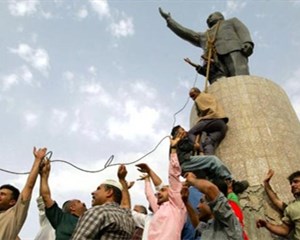American troops would remain in Baghdad until 21 October 2011, eight-and-a-half years after the statue toppling. Thousands of coalition soldiers and hundreds of thousands of Iraqis would die.
美軍將在巴格達駐扎到2011年10月21日,也就是雕像倒塌八年半之后。成千上萬的聯軍士兵和成千上萬的伊拉克人將會死去。
After the troops left, Iraq remained divided, damaged and unstable. In 2014, American soldiers would return to take on the threat posed by Isis, which had emerged from the wreckage to make things even worse.
在美軍撤離后,伊拉克仍然處于分裂、破壞和不穩定狀態。2014年,美國士兵將重返伊拉克,應對Isis構成的威脅。Isis從廢墟中冒出來,讓事情變得更糟。

"Now, when I go past that statue, I feel pain and shame," said Kadhim al-Jabouri in 2016. "I ask myself": Why did I topple that statue?" He regretted the fall of Saddam's regime. What came after, in his opinion, was a disaster: "Saddam has gone, but in his place we now have one thousand Saddams." Kadhim even wanted the statue back. "I'd like to put it back up, to rebuild it," he said. "But I'm afraid I'd be killed."
卡迪姆·賈卜利在2016年說:“現在,當我走過這座雕像時,我感到痛苦和羞愧。”“我問自己”:我為什么要推倒那座雕像?”他對薩達姆政權的倒臺感到后悔。在他看來,接下來發生的是一場災難:“薩達姆死了,但現在我們有1000個薩達姆。”卡迪姆甚至想要回雕像。“我想把它放回去,重建它,”他說。“可是我怕我會被殺死的。”
In the state of hyperreality, it is impossible to tell the difference between reality and a simulation of reality. The thing about reality, though, is that it continues to evolve. Sooner or later, the simulation begins to glitch, then ultimately falls apart.
在超實的狀態下,是不可能區分實相和模擬實相的。但現實是在不斷發展的。這個模擬系統遲早會出現故障,然后最終崩潰。











